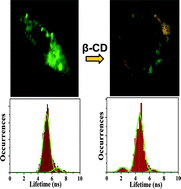Interaction of β-cyclodextrin with nile red in a single live CHO cell: an initiative towards developing a prospective strategy for the excretion of adsorbed drugs from the cell membrane†
Abstract
A successful endeavour has been made to develop a prospective strategy to oust the drug molecules adsorbed on the cell membranes by simply using the non-toxic β-cyclodextrin (β-CD). For this purpose, fluorescent probes of different geometries and charge characteristics, namely phenosafranin (PSF) and nile red (NR), were exploited for the in vitro studies using different lipids as model membranes. Considering the success of the in vitro study, the present work is extended to a live Chinese Hamster Ovary (CHO) cell using the dye NR acting as a model drug system. Steady state and time resolved confocal microscopic studies reveal that with the introduction of β-CD, some of the adsorbed dye molecules are dislodged from the CHO cell membrane to the nanocavity of β-CD resulting in the formation of dye–β-CD inclusion complex. This study promises the development of a prospective strategy for the removal of the adsorbed drugs from the cell membranes.


 Please wait while we load your content...
Please wait while we load your content...